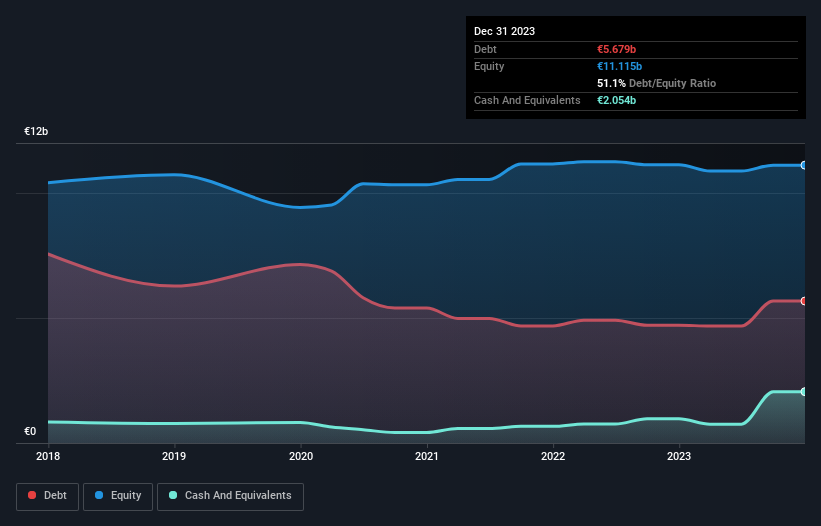Stock Analysis
- Netherlands
- /
- Food
- /
- ENXTAM:JDEP
We Think JDE Peet's (AMS:JDEP) Is Taking Some Risk With Its Debt

Some say volatility, rather than debt, is the best way to think about risk as an investor, but Warren Buffett famously said that 'Volatility is far from synonymous with risk.' It's only natural to consider a company's balance sheet when you examine how risky it is, since debt is often involved when a business collapses. As with many other companies JDE Peet's N.V. (AMS:JDEP) makes use of debt. But the real question is whether this debt is making the company risky.
When Is Debt Dangerous?
Debt and other liabilities become risky for a business when it cannot easily fulfill those obligations, either with free cash flow or by raising capital at an attractive price. In the worst case scenario, a company can go bankrupt if it cannot pay its creditors. However, a more usual (but still expensive) situation is where a company must dilute shareholders at a cheap share price simply to get debt under control. Of course, debt can be an important tool in businesses, particularly capital heavy businesses. When we examine debt levels, we first consider both cash and debt levels, together.
Check out our latest analysis for JDE Peet's
What Is JDE Peet's's Debt?
The image below, which you can click on for greater detail, shows that at December 2023 JDE Peet's had debt of €5.68b, up from €4.71b in one year. On the flip side, it has €2.05b in cash leading to net debt of about €3.63b.

How Healthy Is JDE Peet's' Balance Sheet?
According to the last reported balance sheet, JDE Peet's had liabilities of €5.06b due within 12 months, and liabilities of €6.97b due beyond 12 months. Offsetting these obligations, it had cash of €2.05b as well as receivables valued at €610.0m due within 12 months. So its liabilities outweigh the sum of its cash and (near-term) receivables by €9.36b.
When you consider that this deficiency exceeds the company's €9.36b market capitalization, you might well be inclined to review the balance sheet intently. In the scenario where the company had to clean up its balance sheet quickly, it seems likely shareholders would suffer extensive dilution.
In order to size up a company's debt relative to its earnings, we calculate its net debt divided by its earnings before interest, tax, depreciation, and amortization (EBITDA) and its earnings before interest and tax (EBIT) divided by its interest expense (its interest cover). This way, we consider both the absolute quantum of the debt, as well as the interest rates paid on it.
JDE Peet's's net debt is 3.6 times its EBITDA, which is a significant but still reasonable amount of leverage. However, its interest coverage of 232 is very high, suggesting that the interest expense on the debt is currently quite low. Shareholders should be aware that JDE Peet's's EBIT was down 27% last year. If that earnings trend continues then paying off its debt will be about as easy as herding cats on to a roller coaster. The balance sheet is clearly the area to focus on when you are analysing debt. But it is future earnings, more than anything, that will determine JDE Peet's's ability to maintain a healthy balance sheet going forward. So if you're focused on the future you can check out this free report showing analyst profit forecasts.
Finally, while the tax-man may adore accounting profits, lenders only accept cold hard cash. So we clearly need to look at whether that EBIT is leading to corresponding free cash flow. Over the last three years, JDE Peet's actually produced more free cash flow than EBIT. That sort of strong cash conversion gets us as excited as the crowd when the beat drops at a Daft Punk concert.
Our View
We feel some trepidation about JDE Peet's's difficulty EBIT growth rate, but we've got positives to focus on, too. To wit both its interest cover and conversion of EBIT to free cash flow were encouraging signs. When we consider all the factors discussed, it seems to us that JDE Peet's is taking some risks with its use of debt. So while that leverage does boost returns on equity, we wouldn't really want to see it increase from here. When analysing debt levels, the balance sheet is the obvious place to start. However, not all investment risk resides within the balance sheet - far from it. For example, we've discovered 2 warning signs for JDE Peet's that you should be aware of before investing here.
At the end of the day, it's often better to focus on companies that are free from net debt. You can access our special list of such companies (all with a track record of profit growth). It's free.
Valuation is complex, but we're helping make it simple.
Find out whether JDE Peet's is potentially over or undervalued by checking out our comprehensive analysis, which includes fair value estimates, risks and warnings, dividends, insider transactions and financial health.
View the Free AnalysisHave feedback on this article? Concerned about the content? Get in touch with us directly. Alternatively, email editorial-team (at) simplywallst.com.
This article by Simply Wall St is general in nature. We provide commentary based on historical data and analyst forecasts only using an unbiased methodology and our articles are not intended to be financial advice. It does not constitute a recommendation to buy or sell any stock, and does not take account of your objectives, or your financial situation. We aim to bring you long-term focused analysis driven by fundamental data. Note that our analysis may not factor in the latest price-sensitive company announcements or qualitative material. Simply Wall St has no position in any stocks mentioned.

Simply Wall St
About ENXTAM:JDEP
JDE Peet's
JDE Peet's N.V., together with its subsidiaries, provides various coffee and tea products worldwide.
Fair value with mediocre balance sheet.
